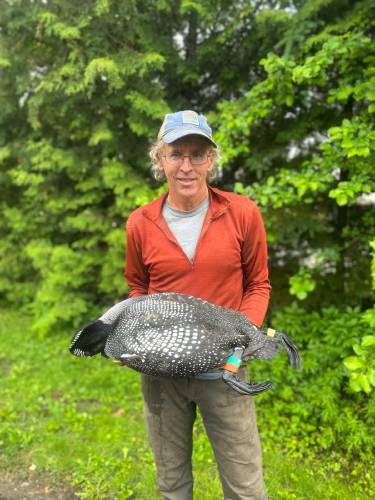Motorboat strike suspected in death of Vermont’s oldest known loon

Loon biologist Eric Hanson holds the Newark Pond male. Eloise Girard photograph
| Published: 07-27-2023 6:18 PM |
Vermont’s oldest known loon died after experiencing blunt trauma, a necropsy has found, suggesting that the bird was killed by a motorboat.
The 31-year-old male was found dead last month in Newark Pond.
Experts initially suspected lead poisoning, according to the Vermont Center for Ecostudies, but determined that the loon had been in excellent health at the time of its death.
The necropsy, performed by Dr. Mark Pokras of Tufts University’s Cummings School of Veterinary Medicine, discovered injuries consistent with blunt trauma. Eric Hanson, a biologist for VCE’s Vermont Loon Conservation Project, suspects the culprit was a motorboat.
“There is really nothing else it could have been,” Hanson told VTDigger.
Telltale signs of a boat injury include bruising of the muscle tissue, typically on one side of the body, and internal bleeding in the body cavity.
Boats, while dangerous for other kinds of birds, generally pose a low risk for loons, according to Hanson. They can typically dive away in time to escape oncoming boat traffic but are less likely to flee if they become accustomed to boat traffic, he said.
According to the Vermont Center for Ecostudies, only nine cases of boats colliding with loons have been documented in the past 25 years.
Article continues after...
Yesterday's Most Read Articles
Most such collisions are unintentional and untrackable, but Hanson said he hopes this incident will raise awareness for boaters to look out for the black-and-white speckled birds.
When operating at high speeds, boaters should note where loon families are and avoid that area, the Vermont Center for Ecostudies advises.
Though loons are no longer listed as an endangered species in Vermont, risks remain — particularly from lead, which the center says is the leading cause of loon mortality.
Hanson had suspected lead poisoning in the case of “Newark Pond Male,” as the loon was known, because an X-ray had found a sinker in its gizzard.
But further examination found the sinker was not made of lead and the bird had an insignificant amount of lead in its body.
While “heartbreaking,” Hanson said, the death of this older loon should not affect the ecosystem, as it would have decades ago. With hundreds of loons in the area, the population was able to replace him right away.
His former female mate nested in late June with another male bird, Hanson said, and the new pair hatched two chicks on an island.

 Enfield Shaker Museum renovations underway
Enfield Shaker Museum renovations underway Art Notes: Canaan Meetinghouse showcase brings musicians and listeners together
Art Notes: Canaan Meetinghouse showcase brings musicians and listeners together A Look Back: Upper Valley dining scene changes with the times
A Look Back: Upper Valley dining scene changes with the times
